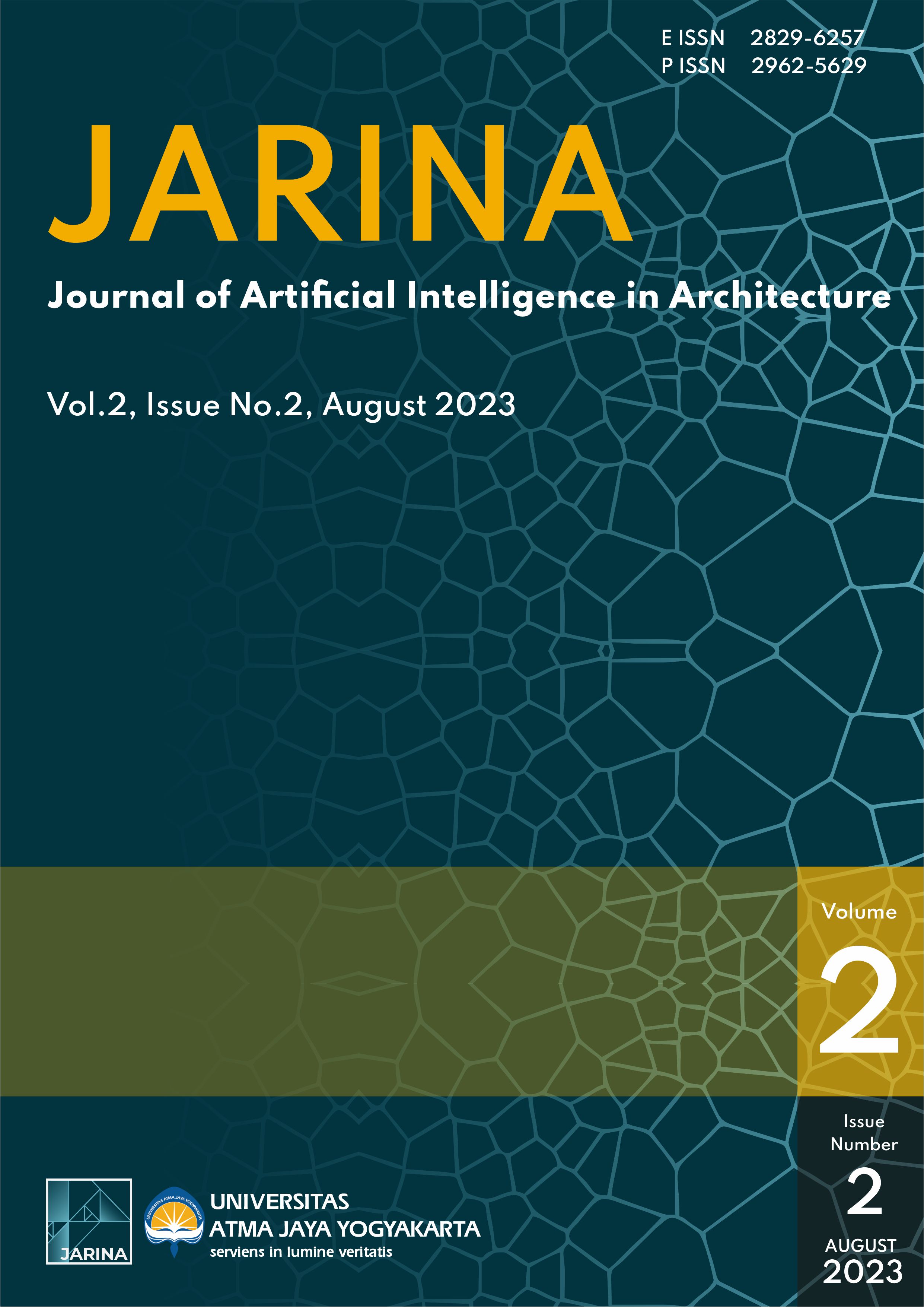A Review Using Artificial Intelligence-Generating Images: Exploring Material Ideas from MidJourney to Improve Vernacular Designs
DOI:
https://doi.org/10.24002/jarina.v2i2.7537Keywords:
Artificial intelligence , Building Materials, Vernacular Architecture, MidJourneyAbstract
Artificial Intelligence (AI) was created to be an assistant to humankind. The architectural design process is one of them. Artificial Intelligence is starting to enter the realm of architecture and design. Lately, teams have developed many AI algorithms to generate random images based on the database they had just by texting a command for them. MidJourney is a discord-based Artificial Intelligence for generating images with the text-to-images method, and its database is infinite; it can suggest incredible things. Architects can use MidJourney as a design ideas generator with specific commands.
MidJourney, one of the AI pioneers in the design world, still has many shortcomings and limitations. Incorrect details and forms are one of its limitations. This exploration using AI should be deepened as part of MidJourney development. This study aims to discover how far researchers have done the command prompt in exploring MidJourney in architecture. This research can be the basis for further research in developing the text-to-image Artificial Intelligence Generator results. This paper uses a systematic literature review method on journals, books, and websites linked with Artificial Intelligence, architecture, and texture selection for building. The systematic literature review involves collecting questions, identifying keywords, screening articles, analyzing, discussing, and concluding.
The results explain the role of Artificial Intelligence in architectural design. MidJourney can choose the proper material for its innovations by generating concept ideas. However, MidJourney has yet to be able to implement the logic of structures and buildings in its design even though it has used architecture-related prompts, perhaps because it was not specifically designed to produce architectural drawings but graphic design only. The challenge is based on the user defining the limitation and the main ideas for generating Artificial Intelligence.
References
Oxford Dictionary, “Artificial Intelligence Definition.” https://www.oxfordreference.com/display/10.1093/oi/authority.20110803095426960 (accessed Jul. 27, 2023).
A. Benko and C. Sik Lányi, “History of Artificial Intelligence,” in Encyclopedia of Information Science and Technology, Second Edition, IGI Global, 2009, pp. 1759–1762. doi: 10.4018/978-1-60566-026-4.ch276.
D. Ismail. Agha, “The Impact of Artificial intelligence on the future of architecture & architects.,” Artif Intell, pp. 3–6, Nov. 2019.
S. Chaillou, “ArchiGAN: Architectural Intelligence x Architecture,” Artificial Intelligence and Architecture, Sep. 2020, doi: 10.1007/978-981-15-6568-7.
A. Maksoud, H. B. Al-Beer, A. Ali Hussien, S. Dirar, E. Mushtaha, and M. W. Yahia, “COMPUTATIONAL DESIGN FOR FUTURISTIC ENVIRONMENTALLY ADAPTIVE BUILDING FORMS AND STRUCTURES,” Architecture and Engineering, vol. 8, no. 1, pp. 13–24, Mar. 2023, doi: 10.23968/2500-0055-2023-8-1-13-24.
T. McCue, “Midjourney AI Based Art Generator Creates Dazzling Images From Words,” Forbes, Jan. 23, 2023.
F. D. Ching, Architecture: Form, Space, and Order, 3rd ed., vol. 3. New York: John Wiley & Sons, 2007.
J. Fernandes, Vernacular Heritage and Earthen Architecture, 1st ed., vol. 1. CRC Press, 2013. doi: 10.1201/b15685.
S. T. Janetius, Architectural Psychology: Space, Psyche, Enigma & symbols. Thrissur: Mishil & Js, Thrissur, 2020.
E. Creangă, I. Ciotoiu, D. Gheorghiu, and G. Nash, “Vernacular architecture as a model for contemporary design,” Mar. 2010, pp. 157–171. doi: 10.2495/ARC100141.
M. Radhakhrisnan, “Is Midjourney-Ai the New Anti-Hero of Architectural Imagery & Creativity?,” vol. 1, no. 1, Jan. 2023.
A. I. BARAKAT, “APPLICATION OF TEXTURE SCHEMES IN ARCHITECTURAL DRAWING AN ANALYTICAL STUDY –FIRST YEAR STUDENTS’ DRAFTS IN DEPARTMENT OF ARCHITECTURE IN UNIVERSITY OF DUHOK,” The Journal of The University of Duhok, vol. 20, no. 1, pp. 15–25, Jul. 2017, doi: 10.26682/sjuod.2017.20.1.3.
J. Ploennigs and M. Berger, “AI Art in Architecture,” Dec. 2022.
A. Jaruga-Rozdolska, “Artificial intelligence as part of future practices in the architect’s work: MidJourney generative tool as part of a process of creating an architectural form,” Architectural and Artificial Intelligence, vol. 1, no. 1, pp. 1–10, 2022.
Z. Mankani, “The Form of Islamic Architecture. Using AI to develop a language for contemporary islamic architecture,” Arch Times vol 39, Pakistan, pp. 12–13, Jan. 2023.
C. Norberg-Schulz, Baroque Architecture. Milano: Electa Editrice, 1979.
E. Omar, “Towards a Self- sustained House: Development of an Analytical Hierarchy Process System for Evaluating the Performance of Self-sustained Houses,” MSA Engineering Journal, vol. 2, no. 2, pp. 56–79, Mar. 2023, doi: 10.21608/msaeng.2023.291864.

Downloads
Published
How to Cite
Issue
Section
License
Copyright (c) 2023 Stephen Tanugraha

This work is licensed under a Creative Commons Attribution 4.0 International License.
Authors who publish with this journal agree to the following terms:
1.Authors retain copyright and grant the journal right of first publication with the work simultaneously licensed under a Creative Commons that allows others to share the work with an acknowledgement of the work's authorship and initial publication in this journal.
2.Authors are able to enter into separate, additional contractual arrangements for the non-exclusive distribution of the journal's published version of the work (e.g., post it to an institutional repository or publish it in a book), with an acknowledgement of its initial publication in this journal.
3.Authors are permitted and encouraged to post their work online (e.g., in institutional repositories or on their website) prior to and during the submission process, as it can lead to productive exchanges, as well as earlier and greater citation of published work (See The Effect of Open Access).
















